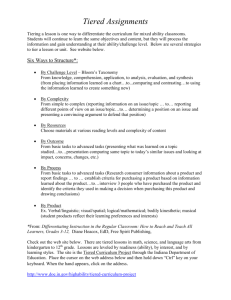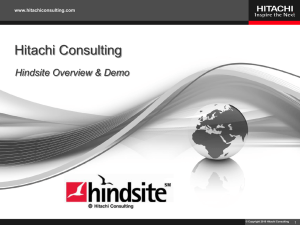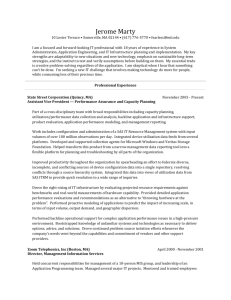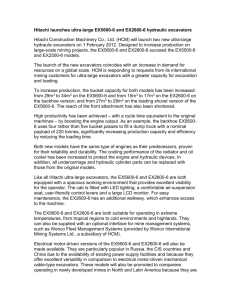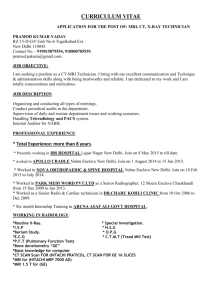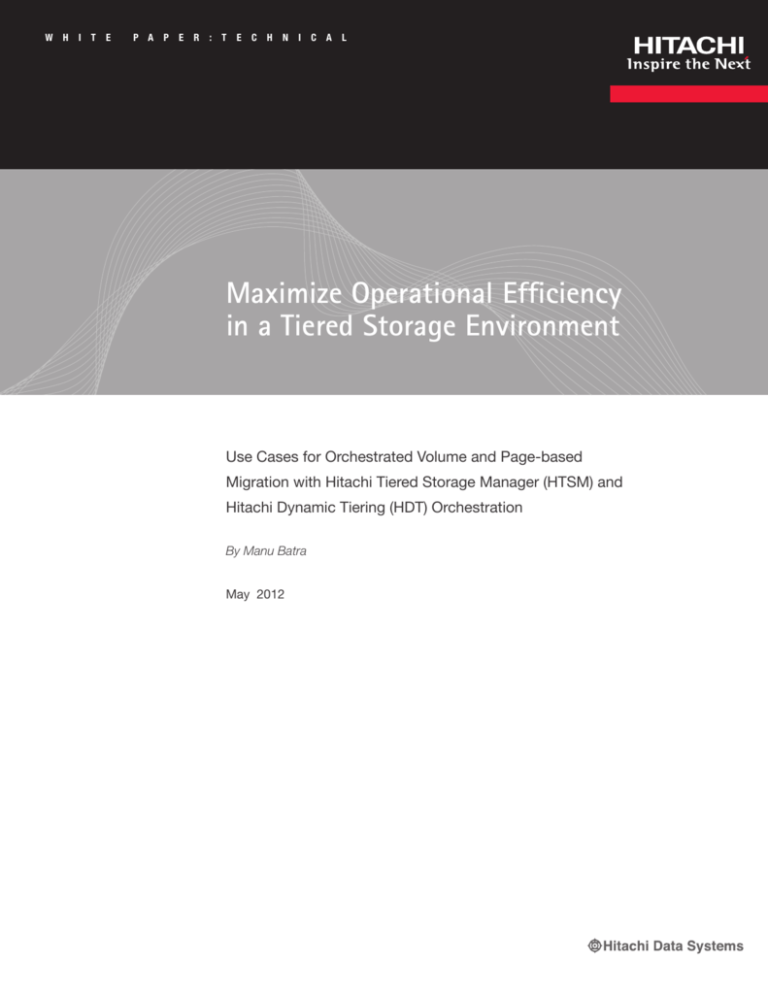
W
H
I
T
E
P A
P
E
R
:
T
E
C
H
N
I
C A
L
Maximize Operational Efficiency
in a Tiered Storage Environment
Use Cases for Orchestrated Volume and Page-based
Migration with Hitachi Tiered Storage Manager (HTSM) and
Hitachi Dynamic Tiering (HDT) Orchestration
By Manu Batra
May 2012
2
Table of Contents
Executive Summary 3
Introduction: Macro versus Micro Data Movement
4
Case 1. Nondisruptively Deploy Existing Application Data into Hitachi
Dynamic Tiering Pools
4
Case 2. Hitachi Dynamic Tiering Pool Balancing: Move Volumes across
HDT Pools 6
Case 3. Cyclic Resource Utilization
6
Case 4. Hitachi Dynamic Tiering Pool Rebalancing
7
Case 5. Reactive versus Proactive Movement of Data
8
Case 6. Hitachi Dynamic Tiering I/O Scheduling
8
Summary
10
3
Executive Summary
Organizations can deploy page-based data movement for Hitachi Dynamic Tiering (HDT) and
volume-based data movement by using Hitachi Tiered Storage Manager (HTSM) to create an optimal and efficient data layout for any application.
The 2 can be used together to efficiently share resources across multiple applications and maximize
storage resource utilization. This white paper offers use cases that describe scenarios in which
HTSM and HDT can work together to maximize the benefits of tiered storage management. The use
cases also emphasize the fact that the 2 products together provide a powerful solution for optimizing storage system layout.
4
Introduction: Macro versus Micro Data
Movement
Page-based data movement delivers an automated, nondisruptive layout optimization in a storage
pool based on input/output (I/O) intensity. Hitachi Tiered Storage Manager volume-based data
movement delivers volume movement across internal and external storage tiers. Both types of
data movement are needed within a data center. The following are key scenarios that describe the
differences.
Case 1. Nondisruptively Deploy Existing
Application Data into Hitachi Dynamic Tiering
Pools
As a part of a Hitachi Dynamic Tiering deployment, existing application volumes need to be moved
into the HDT pools. Hitachi Tiered Storage Manager provides nondisruptive volume migration technology that enables volume migration across internal and external storage systems. The nondisruptive nature of the migration provides organizations with the flexibility to deploy without waiting for
an application or data center maintenance window. It can drastically improve efficiency of the HDT
deployment.
HTSM v7.1.1 has eliminated the need to create migration groups. A new migration wizard enables
migration sources to be selected from logical group constructs, hosts or free-form volume filters
based on configuration and performance data. The performance data allows users to easily identify
hot and cold spots. The system auto-selects target volumes (a user override option is also provided)
and indicates expected performance (improve or decrease) after migration.
Once the migration tasks are created, the system provides an estimated completion time and allows
the migration task to be executed immediately or scheduled to be completed at a later date and
time (see Figures 1 and 2).
5
Figure 1. Migration Wizard Source Volume Selection: Choose source volumes based on
logical groups, hosts, or performance or configuration metrics.
Figure 2. Source and Target Volume Mapping: Migration wizard indicates (by arrows)
performance impact on the volume based on the target volume characteristics.
6
Case 2. Hitachi Dynamic Tiering Pool
Balancing: Move Volumes across HDT Pools
As application storage capacity grows over time, Hitachi Dynamic Tiering pools will reach a maximum either in capacity or I/O. This will require either a capacity increase of the HDT pool or a migration of the application volumes to another HDT pool with available resources to balance the pool
utilization.
Hitachi Tiered Storage Manager will enable users to nondisruptively rebalance the pools by moving
application volumes across the pools.
HTSM also provides specific reports to highlight the pool utilization (see Figure 3). These reports can
quickly highlight whether the pools are reaching a maximum and whether capacity or I/O threshold
have been exceeded.
Figure 3. Data Mobility Pool Summary Report
Case 3. Cyclic Resource Utilization
Certain applications have cyclic I/O profiles (see Figure 4). For example, a quarterly billing application, which experiences low I/O traffic for 11 weeks in quarter, has very high I/O activity during the
last week of the month when customer billing happens.
7
Using Hitachi Tiered Storage Manager volume-based mobility, the volumes can be nondisruptively
moved across storage pools of different compositions [pools with solid state disk (SSD), SAS or SATA
drives to pools with SAS or SATA drives] without impacting application availability. These would be
very effective for storage service providers and customers with cyclic I/O patterns.
Figure 4. Hitachi Tiered Storage Manager: Volume-based Mobility for Cyclical Applications
Case 4. Hitachi Dynamic Tiering Pool
Rebalancing
Hitachi Dynamic Tiering provisioning has thresholds for overprovisioning. Once thresholds have been
exceeded, volumes may be moved, nondisruptively, to pools with more free space. Hitachi Tiered
Storage Manager allows this rebalancing to happen nondisruptively.
It also provides reports to quickly identify pools that will need rebalancing (see Figure 5).
Figure 5. Data Mobility Pool Configuration Report with Thresholds
8
Case 5. Reactive versus Proactive Movement
of Data
Hitachi Dynamic Tiering page movement is reactive in nature; i.e., pages are moved in reaction to
observed I/O patterns. There may be cases where organizations have predictive periods of high
activity for certain application volumes. Hitachi Tiered Storage Manager volume-based movement
can proactively or temporarily move such volumes to HDT pools appropriate for high I/O activity;
then, after the activity has subsided, the volume can be moved back to its original HDT pool (see
Figure 6). This can help organizations achieve a high level of operation efficiency without assigning
permanent Tier 1 storage resources to application that may not need them. It also allows resource
sharing across various applications.
Figure 6. Cyclic Movement of Data across Pools for Macro Optimization
Case 6. Hitachi Dynamic Tiering I/O
Scheduling
■■Hitachi
Dynamic Tiering is designed to react to I/O density by moving high I/O activity pages to
higher storage tier disks.
■■By
default, HDT is constantly monitoring I/O and making decisions to move data within the pool.
9
■■However,
data center I/O cycles are not linear. There may be maintenance, backup and other
non-performance-sensitive time periods.
■■Hitachi
Tiered Storage Manager mobility manager will enable HDT to adjust or schedule monitor-
ing windows to work around non-performance-sensitive time periods (see Figure 7).
Figure 7. Hitachi Dynamic Tiering Monitoring: Capability can be disabled for backup and
maintenance hours of the week.
An example of the HDT Monitoring Schedule Template appears in Figure 8. It depicts scheduling
periods:
■■8:00
a.m. through 16:00 (4 p.m.) at 2-hour cycles, Monday through Friday
■■16:00
(4 p.m.) through 8:00 a.m. at 4-hour cycles, Monday through Friday
■■Saturday
and Sunday using 12-hour cycles.
10
Figure 8. Hitachi Dynamic Tiering: I/O Monitoring Schedule Sample
Summary
Hitachi Tiered Storage Manager volume migration and Hitachi Dynamic Tiering page tiering together
can maximize storage resource utilization and optimize the storage layout for applications across a
Hitachi tiered storage environment.
Hitachi Tiered Storage Manager and Hitachi Dynamic Tiering complement each other by helping
organizations to easily and efficiently realize the following data mobility use cases:
■■Nondisruptively
■■HDT
deploying existing application data into HDT pools
pool balancing: moving volumes across pools
■■Cyclic
resource utilization
■■Hitachi
Dynamic Tiering pool rebalancing
■■Reactive
versus proactive movement of data
To maximize the benefits of a tiered storage management solution, it is suggested that Hitachi
Tiered Storage Manager and Hitachi Dynamic Tiering be used together. Using both products provides a complete solution for optimizing macro and micro data layout across Hitachi tiered storage
environments.
Corporate Headquarters
750 Central Expressway
Santa Clara, California 95050-2627 USA
www.HDS.com
Regional Contact Information
Americas: +1 408 970 1000 or info@hds.com
Europe, Middle East and Africa: +44 (0) 1753 618000 or info.emea@hds.com Asia Pacific: +852 3189 7900 or hds.marketing.apac@hds.com
Hitachi is a registered trademark of Hitachi, Ltd., in the United States and other countries. Hitachi Data Systems is a registered trademark and service mark of Hitachi, Ltd., in the United
States and other countries.
All other trademarks, service marks and company names in this document or website are properties of their respective owners.
Notice: This document is for informational purposes only, and does not set forth any warranty, expressed or implied, concerning any equipment or service offered or to be offered by
Hitachi Data Systems Corporation.
© Hitachi Data Systems Corporation 2012. All Rights Reserved. WP-420-A DG May 2012

